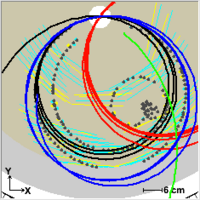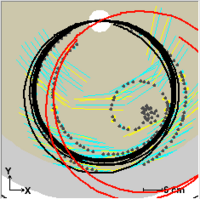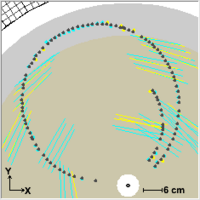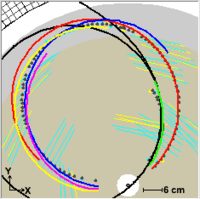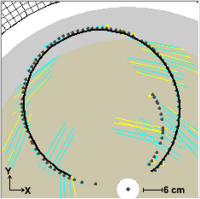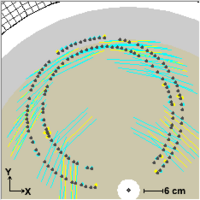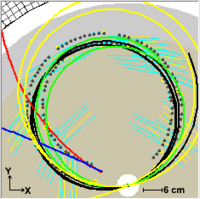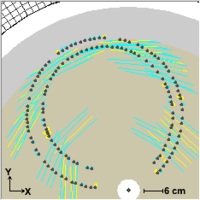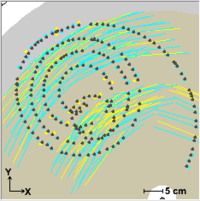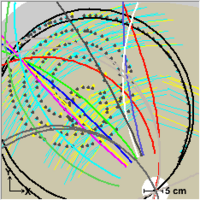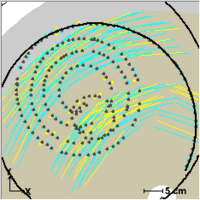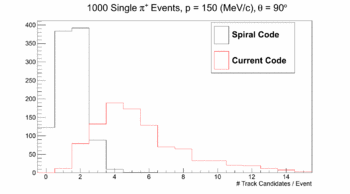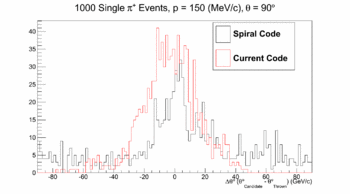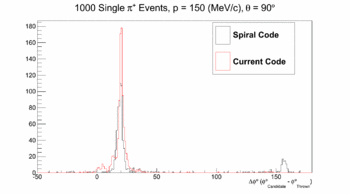Mattione Update 04252012
From GlueXWiki
Contents
[hide]Summary
- Promising start to single-track event pion spiral reconstruction, MUCH work still to do.
Spiral Fitting - Reconstructed Track Candidate Viewer Comparison
- Notes:
- All events have one π+ thrown at p = 150 MeV/c, θ = 90 degrees, φ = random.
- Current Code = Code as of 04/08/12
- Current Code # Reconstructed Track Candidates in events below: 4, 6, 5, 12
- Spiral Code # Reconstructed Track Candidates in events below: 2, 1, 0, 1
- Event 1: Spiral Code reconstructs two tracks due to turn near beamline, will be difficult to reduce to one track.
- Event 2: Spiral Code reconstructs both spiral arms (from the beamline to the edge) and then links them together to form one track
- Event 3: Not sure yet why spiral code fails to reconstruct anything.
- Event 294: Current code ignores stereo hits while trying to link axial hits together by phi: explosion in track candidates
- Event 294: Spiral code has memory explosion (leak?) while attempting to link axial and stereo hits together, need to improve somehow...
| Event # | Hits (CDC & Truth) | Current (04/08/12) Code Track Candidates | Spiral Code Track Candidates |
|---|---|---|---|
| Event 1 | |||
| Event 2 | |||
| Event 3 | |||
| Event 294 |
Spiral Fitting - Histograms
- # Reconstructed Tracks / Event:
- NOTE: Hit selectors disabled for wire based & time based fits: just use hits from track candidates (and ignore hits after spiral turn back inwards (for now anyway))
- Not sure why so few wire-based & time-based tracks reconstructed, possibly due to bad θ reconstruction.
- Track Candidates: Track Parameter Differences (BEST Reconstructed - Thrown)
- Best Reconstructed = Track Candidate that is the closest match to the thrown track.
- NOTE: Δφ = 20 not real, due to artifact: reconstructed track candidate parameters are reported at a point along the track (~)just outside the start counter, whereas thrown parameters reported at thrown vertex (beamline)
- Need to work on θ reconstruction.
Spiral Fitting - Procedure Overview
- Link adjacent hits together within each superlayer
- Link adjacent superlayer hits group together (all possible combinations)
- Fit the axial superlayer hits (and the beamline) to a circle (for each unique axial group combination)
- Reject bad axial group combinations (bad combo if one of its axial groups was already used in a fit that got a lower chisq/ndf)
- Compare the different stereo superlayer hit group combinations to the circle fit, choose the best combination (best = combo with lowest standard deviation of hits from circle fit)
- Calculate track parameters (p, theta, phi, x, y, z)
- Link spiral arms together (look for rings with many consecutive hits shared between spiral arms)

